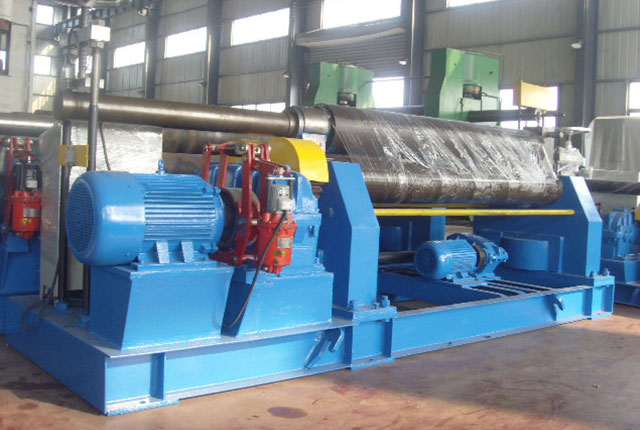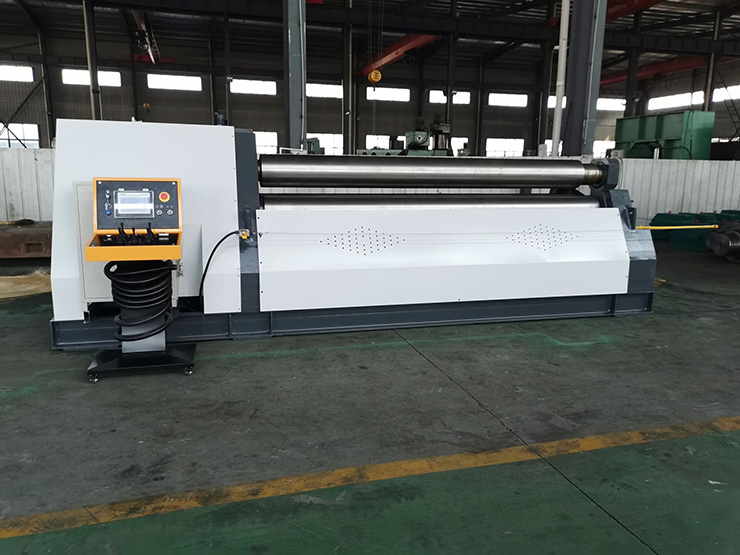WMT CNC Industrial Co., Ltd | All Rights Reserved.Design & Developed by VW Themes

The upper roller of the four-roll CNC bending machine is the driving roller, the lower roller and the side roller are the driven rollers, the position of the upper roller is fixed, the lower and side rollers can move up and down, the upper roller is driven by hydraulic motor, and the rotation of the lower and side rollers rely on steel plate Driven by the friction between the rollers. The lower roller and the side roller are driven by the oil cylinders at both ends to realize the lifting movement. The turning and resetting of the front bearing body of the upper roll are carried out by the oil cylinder. The bearing bodies and oil cylinders of each roll are installed in the frame at the left and right ends. The left and right frames are the main body of the four-roller plate bending machine, which adopts a welding structure and is installed on the integral base. The pushing device is to roll the workpiece, turn it over to the cylinder, and push the workpiece out of the machine. All operations of the machine are carried out on the console.

There are many kinds of rolling process of the CNC plate rolling machine. The user can decide according to his own process. One of them is provided below:
1. Operate the lower roll to rise so that the bus bar is slightly larger than the working thickness from the bus bar below the upper roll. Then operate the feeding side roller to make the upper bus bar on the same level, and then operate the other side to rise between the upper and lower rollers.
2. Feeding: Feed the steel plate horizontally so that the end of the steel plate is in full contact with the front roller for alignment, and then lower the front roller to its original position.
3. Tighten the steel plate and pre-bend the end: according to the thickness and material of the steel plate, adjust the pressure of the lower roll circuit to a value within a specific range, operate the lower roll to lift and clamp the steel plate, start the upper roll to rotate, and when the steel plate moves to the bending position The upper roller stops rotating. At this time, the left end of the center line of the upper and lower rolls should have the necessary tightening length approximately equal to 1.5 times the plate thickness. Then raise the rear roller to pre-bend the end of the steel plate.
4. Pre-bend the other end of the steel plate with the front roller. After pre-bending the left end, lower the rear roller to its original position and start the upper roller. When the steel plate moves to the above-mentioned bending position, the upper roller stops rotating. Operate the front side roller to raise the other end of the pre-bent steel plate, and then adjust the pressure of the roller circuits on both sides.
5. Preliminary bending: adjust the front and rear side rollers to the corresponding positions required by the work, and start the upper roller for final forming and bending.
6. Forming and bending: Take out the workpiece: After the bending is finished, lower the lower roller to the lowest position, the workpiece is lowered to a certain position along with the rollers on both sides at the same time, flip the head upside down, lift the workpiece parallel to the upper roller, take out the workpiece, and complete a work cycle .
Compared with the symmetrical three-roller, the four-roller bending machine can directly pre-bend the end of the plate without the help of other equipment molds, and the remaining straight edges are smaller; compared with the asymmetrical three-roller, it can eliminate the need for plates U-turn, it can be rolled into a workpiece. This not only improves the efficiency and guarantees the quality of the workpiece, but also has simple process and convenient operation, which reduces the labor intensity of workers.